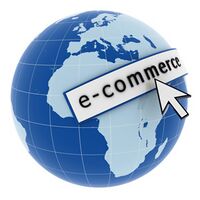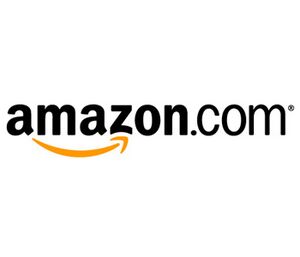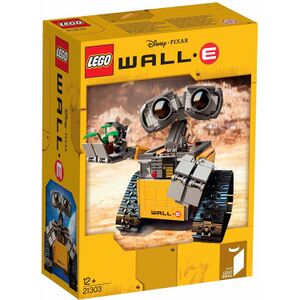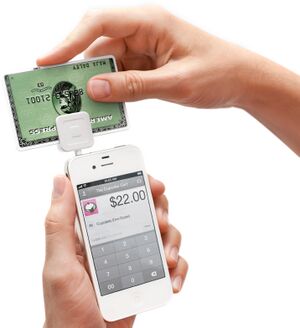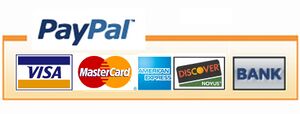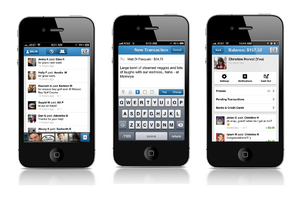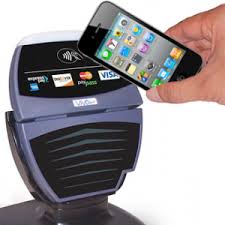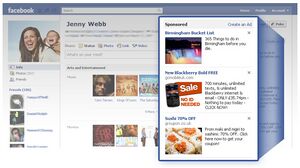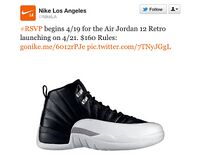How New Media is Used in Business
New media has changed the way businesses connect with consumers and other businesses. Where traditional media consisted of businesses using physical means to promote and conduct activities, new media has revolutionized the business world to one that relies heavily on technology and the Internet. E-commerce (or Electronic commerce) refers to the buying and selling of goods and services via electronic channels, primarily the Internet. [1]. The newest phenomenon is M-commerce (or mobile commerce), which refers to the use of wireless handheld devices such as cellular phones and laptops to conduct commercial transactions online. [2].
E-Commerce
E-commerce refers to the sale and purchase of goods over the Internet. This form of online transaction is convenient and easily accessible round the clock. A business can have the most ingenious idea or product ever invented, but if that business does not have customers to purchase that product from them, they cannot possibly survive. The customer is the most important part of any business. When a company has a local storefront, their customers are limited to the people within that neighborhood. According to the article "The Disadvantages of Brick-and-Mortar Businesses" by Robyn D. Clarke, she states : "Brick-and-mortar businesses can reach only so many customers unless they are a major player in their industry. If your intention is to serve only local clients, this may be fine. But if you aspire to have a national or even global presence, a fixed location -- and the costs that incurs -- may lessen those chances." Even the most popular businesses have limited accessibility due to traveling distance. One is only willing to drive so long to purchase something. Today, fewer people are willing or have the time to make that travel to make a purchase. When a company has an online presence, an E-commerce store, the limits provided by a brick and mortar store are eradicated. The opportunity to reach new consumer markets becomes endless. In the article "Advantages of E-commerce" by Neil Sisson, he mentions an interesting but simple point. If Company A exists in America and Customer A exists in Germany, how can that person possibly purchase the item. Maybe if it was a rare diamond, it would be worth the trip, but what if it was something as simple as a sweater? Yes, you could do an order over the phone but that will lead to many complications and misunderstandings. With an E-commerce store, Customer A can view the sweater, with all the information as far as colors and sizes go, choose their size and see how much shipping will cost to deliver the item to Germany. All of the stores policies and terms are clearly stated along with frequently asked questions that help customers sort out problems before they make their purchase. Without E-commerce this is not possible and Company A would have just lost the sale. Let's say that one sweater was $100 and Company A could have sold 1,000 sweaters to international customers. That is $100,000 lost in sales by Company A simply because they did not have an online presence. That is just based on one item. If you take 10 items like this, Company A has just lost $1,000,000 in sales in one year. These numbers would not only make or break a business but also forgo one million dollars in sales. According to the article "25 Fast Facts About AdWords" by Elisa Gabbert, the Google Display Network gets over 6 billion impressions a day. A business technically has the ability to reach millions of customers when advertising with Google Ads vs. just a few thousand, maybe even a few hundred thousand if you are lucky with Yellow Pages advertising. Google display campaigns reach 80% of global internet users. Just to build on this, the article "Should Small Businesses Still Book Yellow Page Ads?" by Kern Lewis, he states: "In the past, the Yellow Pages were the only reliable resource for retail businesses seeking a local audience. After word-of-mouth, consumers relied heavily on the Yellow Pages for services in a wide range of industries. And it took little work: You placed the ad, it ran for a year and you waited for the phone to ring. Not so today. Multiple studies confirm that consumers report using the Internet first (80% of the time) when they need a new product or service, and printed Yellow Pages only second or third (about 50% of the time.) And even if the consumer does reach for the printed Yellow Pages, your ad still has to stand out (size, graphics and color,) which ups the expense of being in the book. The convenience of “set it and forget it” is now trumped by the more labor intensive but productive SEM options."
Business-to-Business
Business to Business (B2B) is a type of e-commerce that allows companies to do business with each other. An example of this is wholesalers selling to retailers.
Amazon
Amazon is the foremost electronic commerce purchase website. Additionally, it is an example of B2C commerce, which means that businesses sell to consumers directly. Individuals can find a variety of goods and items available for purchase through Amazon. The company was founded in 1994 by Jeffrey "Jeff" Bezos as an online bookstore that intended to compete with Barnes and Noble. Amazon's early business strategy took advantage of the limited inventory selections at physical book stores. While "brick and mortar" bookstores were able to hold up to 200,000 books at a time, Amazon did not rely on a physical inventory and instead opted to enter into contracts with publishers to place orders for the books when online customer orders were placed. With the development of the Kindle, Amazon enabled instant purchasing of e-books and unlimited viewing of previously purchased or stored books on its devices. [3]
Amazon's vision was to be a customer-centric corporation. This is reflected in their company-values statement, which states: "Customer Obsession: We start with the customer and work backwards. Innovation: If you don't listen to your customers you will fail. But if you only listen to your customers you will also fail." [4]
Amazon has lead business in New Media with their research and development. The corporation has recently made an impact in the entertainment industry by advertising and hosting TV shows on its Amazon Prime service. Popular television series such as Downtown Abbey, Suits and Boardwalk Empire among others are available for Amazon Prime members to view in high definition and free of advertisements. It has also ventured into creating its own television shows with the introduction of several "Amazon original series", which remain exclusive to Prime subscribers.
Amazon is also taking a leap into the future with their new Amazon Prime Air Service. It is a delivery service that will deliver packages up to five pounds in about thirty minutes. The prime air delivery vehicles are small drones that are approximately 55 pounds and fly under 400 feet in the air. The vehicles have a system referred to as the "sense and avoid" technology that will allow it to safely navigate in the air and stay a safe distance away from other airborne objects. [5] This service is not available yet to consumers, because it is still in development and the regulations of flying drones still have to be sorted out. This new technology allows people to stay connected even faster. It creates ultimate efficiency for consumers and they are able to have a better consumer experience. With this technology in the future, Amazon has a huge competitive advantage over itscompetitors.
Alibaba Group
Alibaba is China's biggest E-commerce company.Alibaba is not a traditional e-commerce company. It operates an “open marketplace” that connects buyers with sellers. It has created an e-commerce platform that helps small businesses as well as branded manufacturers reach consumers. It does not sell anything directly and does not own any warehouses. As a result, Alibaba is vastly more profitable than Amazon, with margins of almost 40% and earnings of almost $2 billion in the most recent quarter, according to its IPO filing documents. Alibaba is now the biggest ever US IPO after its stock started to be traded on the New York stock exchange in 2014. Alibaba has a deep understanding of the Chinese market which allows it to build an e-commerce platforms uniquely suited to their home markets. Alibaba is largely domestic, which in turns can sound very limiting; yet when one considers the numbers around China's revelation of the web, one can see the advance in e-commerce business. China's e-commerce market has grown tremendously in the last couple of years, so has Alibaba's market share. It is safe to say that Alibaba is the world largest e-commerce business, it handles more transactions than Amazon and eBay combined. Investors have been skeptical about Alibaba's ability to conquer the US market, which would be a major threat to US based e-commerce businesses such as Amazon and eBay. One way that Alibaba has been able to grow so fast is by making many acquisition, which allow the group to expand its border. [6]
Business-to-Consumer
Business-to-Consumer (B2C) is business conducted between a company and consumers who are the end-users of the products and services. New media has made the communication between businesses and consumers quicker and more efficient. Businesses use many new media platforms and social media platforms such as Facebook, Twitter, and (blog websites) to display many of their new products and to syndicate more information about their new products. Through these channels, they are able to publish more content about their business and information on future plans of the company. Not only does this create a more efficient means of communication for businesses to reach their thousands of consumers, it also creates the feeling of a more personal relationship. When businesses are able to reach consumers at a more personal level through these posts, it can help create customer loyalty and enhance their business voice. It helps reach a wider audience and through sharing posts with word-of-mouth advertising. This in turn increases publicity for that business. Businesses that would otherwise never be heard by others would gain the publicity they need to expand and prosper.
Consumer-to-Business
Consumer-to-business (C2B) is business conducted between a consumer and a business in which the business becomes the end-user of the products and services. Consumers co-create ideas for new products and suggest potential solutions to companies through various forms of new media such as Twitter and blogs. The C2B model highlights the importance of a customer-driven market in the digital age. Markets in the past were passive and one-directional as companies pushed goods and services to consumers. Over the years, technology has not only become more advanced but also more affordable as shown in the markets for smartphones, video cameras and high-quality printers. Consumers with access to technology have the tools to promote and communicate their ideas to businesses. The Internet also allows customers to make the brand more visible through word-of-mouth advertisement, which saves companies thousands of dollars. Furthermore, by working with its consumers to understand their needs, businesses can save time and money on predicting future trends and massive production of unpopular goods. Companies with the C2B strategy receive constructive criticism, increase their bottom line from consumers’ inputs, attain greater customer satisfaction and build long-lasting customer relationships. [7] Notable examples of C2B model in the market are:
LEGO Ideas
From a small carpenter’s workshop in Denmark to today’s global brand that is recognized by individuals of all ages, the LEGO company continues to impress past and future generations with its interlocking plastic construction toys for endless hours of imaginative fun. Founded in 1932 by Ole Kirk Kristiansen, LEGO valued quality and branded the company’s motto as “only the best was good enough.” [8] As the digital age flooded the markets with technology, it became difficult for LEGO to compete with other toy and game companies such as Nintendo. In addition, LEGO faced competition from Chinese markets who manufactured similar products at a fraction of the cost. [9] LEGO diversified into various themes to attract customers, but it was unable to determine what its customers wanted.
Through effective customer relationship management, LEGO implemented a theme called LEGO Ideas in which customers would design their own sets and share it with the community through the company’s website. Ideas with at least 10,000 votes would be considered by the LEGO Review Board. If approved, the idea would become an official LEGO set sold worldwide. One of the innovative and popular LEGO Ideas sets that has followed through the various stages and is currently found in stores is Wall-e from the Disney movie. Thus, LEGO incorporates its customers’ and the community’s input into its products as a way to satisfy consumers and to increase sales. [10]
NIKEiD
In 1964, Phil Knight and Bill Bowerman founded Blue Ribbon Sports, which would later become Nike. As a track and field coach, Bowerman wanted to improve the quality of his students’ performance by finding the right footwear. One of Bowerman’s students collaborated with him to launch their own line of shoes in 1971. After years of success and innovation, in 1982, Nike became America’s number one supplier for athletic/training shoes. [11]
In order to allow customers the opportunity to customize their gear, Nike launched NIKEiD in the early 2000s. Customers have the option of choosing the color, the design and the performance features they wanted through the accessible online web service. [12] NIKEiD created a better alignment of the consumer demand and retail supply. This enabled the customers to visualize, create and purchase the goods they wanted and assisted Nike in identifying the various desires of its wide consumer base. By considering the importance of customer relationship management and an engaging shopping experience, Nike was able increase their sales by 22% in July 2015. [13]
Consumer-to-Consumer
Consumer-to-Consumer (C2C) is business conducted between a consumer and another consumer who are both the end-users of products and services. Consumers use new media in the form of blogging to communicate their questions, comments, or concerns to other consumers about certain products. Blogging gives consumers a platform for them to look at what other consumers have to say about specific products or companies. Consumers use these platforms to communicate their thoughts consequently giving the end users a larger network to discuss any concerns about certain products. Other types of new media that has grown over the years is video sharing. More specifically, people have started to upload videos of them talking about certain products or using certain products for the first time. A notable new media platform that has gained immense popularity is YouTube. On YouTube for example, there are many beauty gurus that upload videos of their first impressions on products and show how the product works and looks outside of the package. Video sharing gives other consumers a better idea of how certain products will turn out and how they work outside rather than taking a leap of faith when buying the product.
EBay
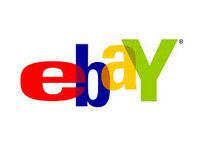
EBay is an online e-commerce site known for its auction capabilities. Created in 1995 under the name AuctionWeb, EBay changed the way people viewed junk. Ebays has since split its sales to 'buy it now' and traditional auctions. Similar to other e-commerce sites, EBay operates as an online marketplace that connects buyers and sellers. Unlike other C2C e-commerce sites such as Amazon, EBay does not maintain any warehouses to store inventory; Ebay does not directly sell any merchandise to buyers (no B2C e-commerce). EBay allows sellers to directly sell to buyers, acting strictly as an intermediary. The company receives revenue from the subscription fees it charges to sellers to list their items for sale. As of 2014, EBay has 155 million active users to go along with $4.35 billion in revenue (as of Q3,2014) [14].
What separates EBay from other e-commerce sites is the ability to list virtually any item (practical or novelty) for sale at any given time. Due to its unique subscription fees, EBay sellers are often incentivized to list items that may not be salable or practical for daily use. Unusual items are frequently listed on the website and subsequent web-traffic leads to media publications on the listings. Since its creation, EBay has listed curious items for sale including: a broken laser pointer, tbe original 'Hollywood' sign, and half of an Apple MacBook. Although unusual items are often listed for instant sale or auction,the media attention on curios combined with negative press on EBay's overall security has contributed to the site's untrustworthy identity.
In addition to its quietly successful online business, EBay has used social media platforms such as Facebook, Twitter and Blogger to raise its brand image. In April 2008, EBay's chief blogger (now), Richard Brewer-Hay started EBay Inc, a blog designed to provide information about the corporation to customers and investors. The blog continues to be updated with new information about the company's business activity and current event articles related to Ebay. Ebay's pages on Facebook and Twitter provide links to advertisements and featured items on their site. Unlike its blog, EBay's pages on other social media technology serve as advertisement hubs used to generate views and web traffic on their main site. In the past, EBay has used Twitter for more creative purposes. EBay made separate Twitter pages to engage users during special events/holidays and gauge interest in certain products. It also created a special Twitter account in December 2012 to handle customer service inquiries during the holiday season[15].
Etsy
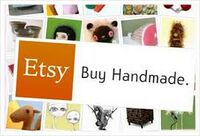
Etsy is a type of C2C e-commerce and can be considered a website dealing with business. It allows anyone, even people who don't have much time to pursue their interests, to put what they create up for sale. It has categories like art, gift ideas, and a section especially dedicated to weddings. Anything you can possibly want can be found on this website. Someone who finds their work on Etsy extremely successful can then have enough confidence to start their small business. Etsy went so far as to allow people to create wedding registries from anything on the site.
Cyber Monday
Cyber Monday, the first Monday after Thanksgiving, is the biggest online shopping day of the year. The term was coined as a result of companies wanting to shift their audience to shopping online as opposed to the traditional Black Friday habits consumers were used to. After first beginning in 2005, Cyber Monday in 2013 was the biggest yet, showing a 20.6% increase in sales from the previous year. [16]. Average order value decreased 1% from the previous year to $128.77, showing that consumers were continuing to find cheaper deals online. [16]. In fact, Cyber Monday 2013 sales were up 31.5% over Black Friday for the same year, while shoppers paid 5% more on Black Friday than they did on Cyber Monday. [16]. Of these online sales, 11.7% were done via use of tablets while 5.5% were as a result of smartphones. The trend seems to be headed toward the direction of a "Black Weekend" instead of a "Black Friday" and then a "Cyber Monday". Experts say that as online shopping gains traction consumers may begin a shift between visiting brick and mortar locations and simply bargain hunting from home, online. [16].
Advertising
In recent years, because of E-commerce, advertising for one's business has changed dramatically. According to the scholarly paper "Socialnomics" by Erik Qualman, he claims that word of mouth has gone to world of mouth. Social media is the new word of mouth and brings upon some improvements in the model. It quickens the spread of the information and the information that is spread is more accurate. When someone shares something from a website via Twitter or Facebook, the company put what they want into that shared link, there is no chance for the person sharing the information to skew the information by accident. While it is still possible to advertise the old school way through newspapers and Yellow Page ads, these methods are not very efficient from a results nor from a cost standpoint. I personally create websites mostly for local businesses. Through a recommendation from a friend, a local roofer wanted an online presence to help expand his business. He was currently advertising through the Yellow Pages at a cost of about $200 per month and also locked into a contract of 1 year. This is the only form of advertising he had partaken in other than word of mouth advertising. Over the years the roofer had received some sales leads from the Yellow Pages advertisement, mostly from old school customers who still used this form of looking up vendors to use for work. Overall, the majority of his business was via word of mouth. I asked him to let me make him a website and advertise it with Google AdWords with the same budget of $200 per month. He would not have to sign a one year contract and could stop the project in a minutes time. He could cancel at anytime with basically no risk. At worst he had a website to show off his business to potential customers. He was very skeptical but knew me as a stand up person so he went along with my low risk plan. I made him a website and advertised the site via Google AdWords. He only wanted to advertise within the limits of Queens, Long Island and Brooklyn so that is what I did for him and Google made this very easy to accomplish. Within days he had received a few calls and one of those calls turned into a $4,000 roofing job. The cost of advertising up until this point was under $30. He hadn't remembered when he actually got a job via the Yellow Pages, so he was beyond thrilled when this new venture we tried actually came through. This is just one small story in a bigger picture and it signifies a big change in advertising for businesses. According to the article "25 Fast Facts About AdWords" by Elisa Gabbert, in August of 2012, 97% of Google's total revenues came from advertising. That number equates to $32.2 billion of the total $33.3 billion in sales. The article also claims that businesses make $2 for every $1 they spend on Google advertising. If all businesses could get a 2 to 1 return on their invest, there would be no such thing as a failing business. Advertising with Google AdWords also introduces a new phenomenon called remarketing. According to Webopedia, In email and online marketing, remarketing or ecommerce remarketing refers to the techniques, strategies and often the automated email systems used by marketers and online merchants to follow up with website visitors who do not make a desired action on the Web site¬—usually it is when they abandon their shopping cart. Think of it like this: you use marketing to bring a visitor to your website, and if he or she doesn't make a purchase, you then use remarketing tactics to bring the visitor back to your website and convert him or her in to a paying customer. Going back to a presentation I quoted earlier in the paper, Adhere Training says that Yankee Candle increased their conversions by 600% by using remarketing and actually cut their costs per acquisition in half. These are real numbers that are transforming companies that are investing into E-commerce. The possibilities are almost endless when advertising for your E-commerce website. Before my current job, I had started my own E-commerce business called Attic NYC. I sold used music gear & equipment. It is very hard to grow your business organically on the web but when I started advertising via Google Product Listing Ads, my products appeared next to the same items being sold by Sam Ash and Guitar Center. Being listed next to those names who are well known in the music industry gave me instant credibility. Within the first month I had over $5,000 in sales alone just advertising via Google Product Listing Ads. Microsoft and Yahoo do offer a similar service as Google advertising however since Google dominates the market, I would only suggest a person to move onto Microsoft and/or Yahoo only after they have taken advantage of all of the goodies that Google has to offer.
Social Networking
Social networking has also had a major effect on the way consumers and businesses conduct commercial activities, especially in the e-commerce and m-commerce world. Advertisers find value in the information they receive from Twitter and Facebook users about their interests, but entrepreneurs are starting to make this transformation from user activity to businesses to an even more direct level. Platforms such as Pinterest, which allows users to share cut-out shaped images of products they like, does just this. [17]. With about 50 million users, Pinterest is a gold mine for advertisers as they are directly see what consumers in various demographics are interested in buying. [18]. According to the Pinterest Executive Ben Silberman, " there is a direct link between the things you pin and the things that you spend money on." [19]. This phenomenon itself is very interesting and we'll see how Pinterest utilizes their data to turn a profit in the coming years.
Many social media sites gain most of their revenue through advertising and promotions on the site. These promotions often include direct links to products or the companies site. Some people who have a large amount of followers sell their account to someone else who completely changes the account name and information to start promoting or advertising to the followers that were originally following the other account. Snapchat just came out with an update that you can literally send cash from your bank account to your friends through this app.
M-Commerce
Many choose to think of mobile commerce as meaning "a retail outlet in your customer’s pocket." [20].
There are many reasons why mobile E-commerce sales are breaking records every year. According to the infographic by Invesp, these were the reasons for consumer preference of mobile shopping: 1. 73% said it was a timesaver. 2. 69% said it was easier to find a good deal. 3. 69% said they could do it on the go. 4. 63% said they could do it while multitasking. 5. 55% said they don't have to wait in line. These stats bring up some interesting points. 63% of people said they could do it while multitasking means to me that those who multitask seem to thrive in today's world and they don't want to put specific time aside for shopping while they can do it while at work or during some other event during the day. 55% of the people interviewed said they don't have to wait in line is also interesting for the same fact. We live in a very fast paced world. While I don't necessarily agree with the famous phrase "time is money", for a lot of people in today's world, time IS money and I can respect that. In general when looking at all these stats, they all seem to have something in common, they make shopping easier and more convenient for the customer which will lead to obvious sales. According to a graph by the eMarketer, mobile commerce sales went from $13 billion a year in sales in 2011 to $25 billion in sales in 2012. The number is projected to be $38 billion in 2013. By 2016, that number will topple $80 billion in purchases done by just mobile devices.
Mobile Payments
With the surge of m-commerce, the mobile payments industry is a rising sector that is transforming the way both consumers and businesses conduct commercial transactions. Mobile payments refers to payment through the convenience of their mobile device. The industry ranges from big companies such as Google and Apple offering these services to the smaller but innovative startups such as Square & Braintree. Entrepreneurs and business executives are seeing this product as one that may gain a lot of traction among consumers in a decade or so, where they expect consumers to use such platforms the way they use credits cards today. According to industry experts, the trend in international commerce is towards a "cashless society". This places mobile payment companies up against traditional commerce giants like Visa and Mastercard. [21]
PayPal
Paypal is a platform that allows its users to send payments to each other through money transfers. Such money transfers replaces traditional payments such as checks and money orders, and even credit card charges, for online purchases. Paypal came to existence in Palo Alto, California. The headquarters of Paypal is located in San Jose, California. Founded by Max Levchin, Peter Thiel, Luke Nosek, and Ken Howery in 1998, Paypal gained popularity with the intensive use from eBay. This even led to eBay's acquisition of PayPal for $1.5 billion in 2002. PayPal generates revenue by collecting a royalty for providing its services of approximately 2% per transaction. For the fiscal year of 2012, PayPal was able to generate $5.6 billion in revenue.
Today, e-commerce around the world including eBay, Amazon and many other online merchants utilize the convenience and protection of payments through PayPal.
Chase QuickPay
Chase is currently known as one of the Big Four banks that exist in the United States today. Chase started out as a bank recognized as Chase Manhattan Bank until the year 2000 it merged with J.P. Morgan and became JPMorgan Chase bank.[22] Just like every other bank, Chase has checkings, savings, deposits, credit cards and accounts. But as technology advanced, Chase also improved and has created what money magazine calls “the best mobile app.” [23] Today, with Chase’s convenient app; customers are able to check their account, deposit checks, pay other people, transfer money and much more. With the function known as QuickPay, users can send money to (or request money from) others who also has a Chase account with QuickPay. After the amount is sent, both parties receive an email notification indicating money was either sent, requested or received. Another great feature is deposits. Customers can deposit their checks through the app by simply taking a picture of the front and back of the signed check then uploading it for verification. Usually money is deposited into the account one business day after it is uploaded and verified. This app not only makes mobile payments easier but it also makes banking more convenient.
Venmo
Venmo is similar to Chase’s QuickPay app. It’s a free app that allows users to send and receive money transactions. The only difference is that Venmo is not limited to customers of a certain bank unlike Chase. People can transfer money from different bank accounts such as HSBC, TD Bank, Citi Bank and more. Whether it’s a debit card or a credit card, which includes a small fee of three percent per payment, people are able to send each other money through Venmo.[24] Venmo is indefinitely made for peer to peer transactions. Whether it’s paying for rent or paying back for a meal, Venmo is able to process these transactions within one business day.
Besides quick payments, Venmo also has other features. People can write a small note to the person they send money to, which seems to enable social networking as well. Besides that, another way this app demonstrates social networking is that there’s a social feed, which enables friends to see whom one made a payment to. [25] In addition, if Venmo is linked to one’s Facebook account, the payment will be shown on Facebook as well and others would be able to comment on that activity. If one doesn’t want others to see the transactions, one can set it to private so only certain individuals can see what transactions were made.
Presently, Venmo is owned by PayPal. Compared to Starbuck’s mobile payment app, Venmo has only taken two years to get to the current standing of Starbuck’s transactions which is over 300 million dollars. [26] Venmo is slowly growing and is constantly used by users every day to receive and make payments.
Square
Square is a mobile payment company that was created in 2009 and headquartered in San Francisco, United States. Jack Dorsey, CEO of Twitter, and Jim McKelvey are the founders of Square. Square allows individual, small and large businesses to accept offline credit and debit cards on Android, iOS smartphones or tablet computers. Square currently works in the United States, Canada and Japan. Major businesses such as Starbucks and Whole Foods Market use Square to accept transactions from consumers. [27]
Square is very simple to set up. You simply sign up and you will be sent a free Square Reader that will accept payments on an iPhone, iPad or Android. Then you download Square Register app that works with the reader to turn your smartphone into a mobile point of sale. You are able to send receipts through email or text message. Square accepts Visa, MasterCard, American Express and Discover. Your deposits will be sent to your bank account in one to two business days. [28]
Square Reader can put directly into the audio jack of your smartphone or tablet that is used for payments. The Square Stand can be bought separately for $99 and is used as a rotatable base. Square charges a fee of 2.75% on every credit card transaction or 3.5 percent plus 15 cents per transaction for manually keyed-in cards. There are no monthly fees or set-up costs which makes it a popular alternative to more expensive services. [29]
From January 2014 Square is valued at $5 Billion dollars. They have Series A funding from Khosla Ventures, series B funding from Sequoia Capital, Series C funding from Kleiner Perkins Caufield & Byers, and Series D funding from Citi Ventures. [30]
Near Field Communication
In recent years, Near Field Communication aka NFC, has been used a lot in new smartphones. [31] NFC technology allows users to use their phones to pay for things at stores which subscribes to the service. Apps like Google Wallet, allows users to link and sync their credit cards to their phones and they can pay for things in a matter of seconds.
Apple Partners with Chase
In September of 2014, when Apple had unveiled its new iPhone 6 and iPhone 6+, it had announced the addition of a new digital payment and digital wallet payment system called Apple Pay. Using NFC, Apple will make a connection between a merchant's cash register (in close proximity) and and phone itself, allowing consumers to pay their purchases with just a touch of their phone. This will remove from the transaction traditional card features that can make consumers vulnerable to fraud: exposed card numbers, security codes and the magnetic strips that hold the information. Apple Pay will generate a security code specific to each transaction for authentication purposes.[32]
Using the phone's camera, the user can take a picture of their credit card and be able to store that information within the phone's "Passbook." All the information is secured with their TouchID, a feature that only allows the owners fingerprint to open the phone. Transactions made through Apple Pay reveal very little information to merchants. Cashiers don’t see your name, card number or security code, and Apple doesn’t get information about where you shopped, what you bought or how much you paid. To authorize a transaction, a consumer only needs to press the right finger to the phone screen using the TouchID system.[33]
The biggest banks and card handlers – Bank of America, Wells Fargo, Citigroup, U.S. Bank, JPMorgan Chase, Capital One, United Services Automobile Association (USAA), Barclays, PNC Financial Services Group (PNC) and Navy Federal Credit Union – are all on board to handle transactions made with Apple Pay. Between them, Apple says they handle 83% of credit card purchase volume.[34]
Apple says 220,000 merchants accept mobile payment system transactions, including Macy’s, Bloomingdales, Walgreen’s, Staples, PetCo, Toys `R’ Us, Subway, Whole Foods, Disney, McDonald’s, Nike and more. Also signed up are Starbucks, Major League Baseball, Tickets.com, Instacart, Sephora and OpenTable.[35]
Apple Pay will pair with e-commerce applications such as those used by Target, Groupon, Uber and Panera. Users can make purchases through the apps and pay with one touch – no credit card number needed.[36]
Square Cash
Square Cash is an app that is owned by Square Inc. Square Inc. is a mobile payment company that was created in 2009 and headquartered in San Francisco, United States. With this new development of an app they are able to make their payment system more personal rather than for business use. Square Cash is similar to the app Venmo, in terms of that it is an app that allows users to send and receive money transactions by using their credit or debit cards. This app is available on both iOS and Android devices. The advantage this app has on its competitors Venmo, PayPal, and Google Wallet is that it does not require an additional fee of 2.9% on the use of credit cards.[37] This means that when you make a transaction that uses your credit card you will actually be charged a little bit more. This can be an incentive for people to currently use this app, rather than the competitors.However, some believe that this advantage will be short lived. In March 2015, Square Cash has made their app more relatable for businesses as well. They are simply trying to make the app more suitable for all aspects of business. Another unique feature that Square Cash has is that it does not require you to make an account. You simply just put in your card's information and allow the transaction to occur. This allows people to feel as if they have the freedom to use the app whenever they want to and they are not forced to make a commitment. Making the app simple to use, with fast transactions, is what attracts customers away form the competitors.
Square Cash provides incentives for people to join and create a network of users. When you invite a family member or friend and they send their first $50 both of you will receive a $5 reward added to your account. This helps create a community of people who will invite each other and continue to use the app because of the bonuses they will receive. [38]
Fashion
Fashion refers to popular trends, styles or practices in clothing, footwear, accessories, makeup, or furniture. It is the culmination of a distinctive style and habits that make up what a person chooses to wear. Generally, fashion is split into either masculine or feminine, but can cross gender barriers. Although fashion is generally thought of simply as the way we dress, it also refers to the study of clothing itself. [39]
The Use of Social Media in Fashion
Although the businesses in the fashion industry have only recently begun to effectively use social media the effects of it are already prevalent in the industry. Social media allows businesses to interact with current and future customers like never before. According to Macala Wright Lee, “The Fashion Industry has adopted social media as a marketing platform to reach their customers online and reignite brand passion and customer loyalty.” [40] Social Media also allows fashion companies to advertise through many different forms. The conversation created on social media coupled with the accessibility of it make it a great tool for companies to use to build brand awareness and customer loyalty. Additionally, it also affords an inexpensive and effective way for fashion brands to market to the young adult population.
Advertising
The biggest use of social media in fashion is advertising campaigns. Social Media allows companies to access a large market using a variety of social media apps.
The advertising featured of Facebook varies from basic product promotions to limited time coupon promotions, all catered to each user by Facebook using that individual's search history and interests. The strongest advertising tool Facebook provides is the feedback it gives to companies in regards to how engaging their ads are. These are a few of the metrics and tools Facebook provides:
- App Engagement: The number of actions, including app installs, credit spends and uses as a result of your ad.
- Click Through Rate (CTR): The number of clicks you received divided by the number of impressions.
- Frequency: Frequency is the average number of times your ad was shown to each person. You may see this number both at the ad and ad set level of a campaign.
- Impressions: The number of times your ad entered the screen for the first time.
- Likes and Interests: Likes and Interests allows you to refine your ad's target audience based on what they've included in their profiles, as well as the Pages, groups and other things on Facebook they've connected with. This includes sections like interests, activities, favorite music, movies and TV shows. Your audience won't be shown the ad because they search for the term you've targeted or as a result of other actions they take on Facebook.
- Offer Claims: The number of claims on your offers as a result of your ad.
- Unique Clicks: The total number of unique people who have clicked on your ad. For example, if 3 people click on the same ad 5 times, it will count as 3 unique clicks.
- Website Conversion: The number of conversions that happened on your website as a result of your ad. [41]
Fashion Communities
Another development social media has created is online communities and networks of users who share the same interests. In the case of fashion, social media allows users to promote their own style, share their tips and how-to's, view what is trending etc. Given the trendy nature of both fashion and social media, both are able to easily inspire the other.
The popular social media app, Instagram, allows users to post images of anything (as long as they follow rules and regulations) and tag it as they see fit. Its primary feed consists of posts made by users one "follows." However, one can also search through Instagram using the different tags a person chose to include. This is especially useful for fashion trends because tags are not owned or controlled by one single user. For example, the hashtag '#louisvuitton' is not owned by Louis Vuitton itself; any user can upload a photo and include this tag. Therefore, the result of trending topics on Instagram is an aggregate of the opinions and references of everyday consumers. One of the more popular fashion related tags shown to the right is 'OOTD,' which stands for outfit of the day. Users are encouraged to post images of their own personal style for the day. This can be used to inspire others searching through this tag or to allow businesses to survey the style that millennials (the primary users of social media) are interested in on a day-to-day basis. Instagram also shows posts of random users who one might share interests with. For example, if you follow or like the posts related to diet or weight loss, Instagram will show other users' posts of diet and weight loss. [42]
YouTube
The use of YouTube in fashion is twofold and is seen primarily from 'vloggers' (video bloggers). Users are able to upload videos offering their own personal tips and how-to's on style. For example, a famous DIY vlogger Yuya, gained her over 9 million subscribers [43] by making how to videos on make up, hairstyles, and clothing styles. Through these channels users can not only provide insight into current fashion trends, but also add their own personal flair.
Businesses can also use YouTube for advertising on all videos. However, similar to users they can also create videos featuring their own designs or experts from their own companies discussing their own personal fashion tips.
This web and mobile app is used to share pictures, and it is used as a "catalog of ideas". These pictures known as "pins" can be sorted into the same category into "pinboards", so other users can easily browse through the different categories for ideas. The fashion community is huge on Pinterest in which there are many users pinning different outfit ideas, and other users looking for outfit ideas. For example, if one wants to ideas of what to wear in the Fall, one can search "Fall outfits", and will find different outfits to wear for the Fall. This is useful as it is easy to search for ideas and see the current fashion trends.
Clothing stores and other businesses can also use Pinterest to promote their different trends, and sales. A study conducted on these "virtual storefronts" show that Pinterest users spent $180 compared to $85 from Facebook users. This study shows that users spend more time on these virtual storefronts on Pinterest, and is the most effective social media platform to increase sales[44].
Successful Social Media Campaigns
TopShop
An example of a successful social media campaign in fashion was seen in 2012 by the brand Topshop. Partnering with Facebook to live stream their London fashion show, TopShop was able to break audience records. Over 200 million users logged on and viewed the show via Facebook and the results of this stream were seen immediately. Items shown on the catwalk were available for purchase as soon as they were introduced driving a large amount of sales for TopShop; the first dress even managed to sell out before the show had ended. The reasoning behind TopShop's move to broadcast their fashion show online was driven by an attempt to capture and monetize on the social audience as described by TopShop's chief marketing office, Justin Cooke; "People have been trying to figure out for some time, how do you make these ’likes’ into something relevant, how does the social aspect mix with your brand, and I think we are going to be the first brand to unlock that, we’re going to be the case study...(to) commercialise that social audience." [45]
Nike
Nike has also taken advantage of the increasing popularity of e-commerce and social media. As shown on the right, Nike uses Twitter as a medium to announce new releases, allow users to RSVP for shoes and even to take orders from customers. This method of limited sneaker releases has proven to be extremely successful as consecutive weekly sneaker releases sell out in a matter of minutes. The information is available in real-time and easily targets the correct audience who are interested in these new sneaker releases.
References
- ↑ http://mashable.com/category/e-commerce/
- ↑ http://www.investopedia.com/terms/m/mobile-commerce.asp
- ↑ http://btmaushart.iweb.bsu.edu/profile.html/Home.html
- ↑ http://jobsearchtech.about.com/od/companyprofiles/a/Amazon.htm
- ↑ http://www.amazon.com/b?node=8037720011
- ↑ http://www.forbes.com/sites/chriswright/2014/09/16/so-what-exactly-is-alibaba/#32765ba11574
- ↑ http://www.businessnewsdaily.com/5001-what-is-c2b.html
- ↑ https://www.lego.com/en-us/aboutus/lego-group/the_lego_history/1930
- ↑ http://knowledge.wharton.upenn.edu/article/innovation-almost-bankrupted-lego-until-it-rebuilt-with-a-better-blueprint
- ↑ https://ideas.lego.com/howitworks
- ↑ https://successstory.com/companies/nike-inc
- ↑ http://www.forbes.com/sites/greatspeculations/2015/07/09/how-nikeid-is-helping-nikes-push-for-greater-profits/#5e14a3c648b7
- ↑ http://www.huffingtonpost.com/danny-wong/nikeid-makes-100m-co-crea_b_652214.html
- ↑ http://expandedramblings.com/index.php/ebay-stats/
- ↑ http://mashable.com/2012/02/22/ebay-social-media-strategy/
- ↑ 16.0 16.1 16.2 16.3 http://www-01.ibm.com/software/marketing-solutions/benchmark-reports/benchmark-2013-cyber-monday.pdf.
- ↑ http://www.businessweek.com/articles/2013-10-24/why-investors-love-pinterest-so-much
- ↑ http://www.businessweek.com/articles/2013-10-24/why-investors-love-pinterest-so-much
- ↑ http://www.businessweek.com/articles/2013-10-24/why-investors-love-pinterest-so-much
- ↑ http://en.wikipedia.org/wiki/Mobile_commerce
- ↑ http://www.bloomberg.com/news/2013-10-27/should-we-ditch-cash-for-good-.html
- ↑ http://en.wikipedia.org/wiki/Chase_(bank)
- ↑ https://www.chase.com/online-banking/quickpay
- ↑ https://venmo.com/about/product/
- ↑ https://venmo.com/about/product/
- ↑ http://www.businessinsider.com/venmo-is-the-killer-app-that-the-mobile-payments-industry-has-been-waiting-for-2014-6
- ↑ http://firstround.com/company/Square
- ↑ https://squareup.com/?sro=1
- ↑ http://www.cardfellow.com/blog/square-review-rates-fees/
- ↑ http://www.crunchbase.com/organization/square
- ↑ http://en.wikipedia.org/wiki/Near_field_communication
- ↑ http://www.nerdwallet.com/blog/tips/hacks-and-deals/chase-apple-pay-credit-card/
- ↑ https://www.apple.com/iphone-6/apple-pay/
- ↑ https://www.apple.com/iphone-6/apple-pay/
- ↑ https://www.apple.com/iphone-6/apple-pay//
- ↑ https://www.apple.com/iphone-6/apple-pay/
- ↑ http://www.wsj.com/articles/SB10001424052702304536104579558071421978060
- ↑ https://squareup.com/help/us/en/article/5441-invite-your-contacts-to-try-square-cash
- ↑ http://wwd.com/fashion-news/
- ↑ http://mashable.com/2009/12/21/social-media-fashion/#HfW6PYqxGkqT
- ↑ https://www.facebook.com/help/447834205249495/
- ↑ http://www.nytimes.com/2014/04/10/fashion/fashion-in-the-age-of-instagram.html?_r=0
- ↑ http://vidstatsx.com/youtube-top-100-most-subscribed-how-to-style-channels
- ↑ https://en.wikipedia.org/wiki/Pinterest
- ↑ http://www.lfpress.com/2012/09/18/fashion-meets-social-media-at-london-fashion-week
